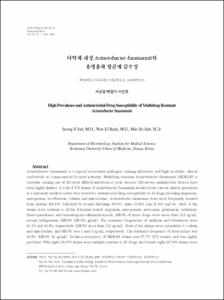다약제 내성 Acinetobacter baumannii 의 유병율과 항균제 감수성
- Keimyung Author(s)
- Suh, Seong Il; Baek, Won Ki; Suh, Min Ho
- Journal Title
- Keimyung Medical Journal
- Issued Date
- 2012
- Volume
- 31
- Issue
- 1
- Keyword
- Antimicrobial susceptibility; Colistin; Minocycline; Doxycycline; Imipenem; Levofloxacin; Multidrug resistant Acinetobacter baumannii (MDRAB); Prevalence
- Abstract
- Acinetobacter baumannii is a typical nosocomial pathogen causing infections and high mortality,
almost exclusively in compromised hospital patients. Multidrug resistant Acinetobacter baumannii (MDRAB) is currently causing one of the most difficult infections to treat, because efficacious
antimicrobial choices have been highly limited. A total of 176 strains of Acinetobacter baumannii
isolated from various clinical specimens in a university medical center were tested for
antimicrobial drug susceptibility to 24 drugs including imipenem, meropenem, levofloxacin,
colistin and minocycline. Acinetobacter baumannii were most frequently isolated from sputum (84.1%), followed by wound discharge (8.0%), urine (2.8%), pus (2.3%) and etc. Most of the strains were resistant to all the ß-lactams tested, imipenem, meropenem, aztreonam, gentamicin, netilmicin, fluoroquinolones and trimethoprim-sulfamethoxazole. MIC90 of these drugs were more than 512 ㎍/mL, except carbapenems (MIC90: 128-256 ㎍/mL). The resistance frequencies of amikacin and tobramycin were 63.1% and 60.8%, respectively (MIC90: more than
512 ㎍/mL). Most of the strains were susceptible to colistin and minocycline, and MIC90 was 1 and 4 ㎍/mL, respectively. The resistance frequency of doxycycline was 10.8% (MIC90: 32 ㎍/mL). Isolation frequency of MDRAB strains was 97.7% (172 strains) and was highly prevalent. Fifty eight (33.0%) strains were multiply resistant to 20 drugs, and twenty eight (15.9%) strains were multiply resistant to 19 drugs. All of the MDRAB were multiply resistant to more than 16 drugs. We need concerted multidisciplinary efforts to preserve the efficacy of currently available antimicrobial agents, by continued surveillance of MDRAB prevalence and antimicrobial resistance patterns that is important to choose effective drugs for MDRAB infections.
- Alternative Title
- High Prevalence and Antimicrobial Drug Susceptibility of Multidrug Resistant Acinetobacter baumannii
- Publisher
- Keimyung University School of Medicine
- Citation
- 서성일 et al. (2012). 다약제 내성 Acinetobacter baumannii 의 유병율과 항균제 감수성. Keimyung Medical Journal, 31(1), 83–93.
- Type
- Article
- 파일 목록
-
-
Download
 다약제 내성 Acinetobacter baumannii 의 유병율과 항균제 감수성.pdf
기타 데이터 / 640.74 kB / Adobe PDF
다약제 내성 Acinetobacter baumannii 의 유병율과 항균제 감수성.pdf
기타 데이터 / 640.74 kB / Adobe PDF
-
Items in Repository are protected by copyright, with all rights reserved, unless otherwise indicated.